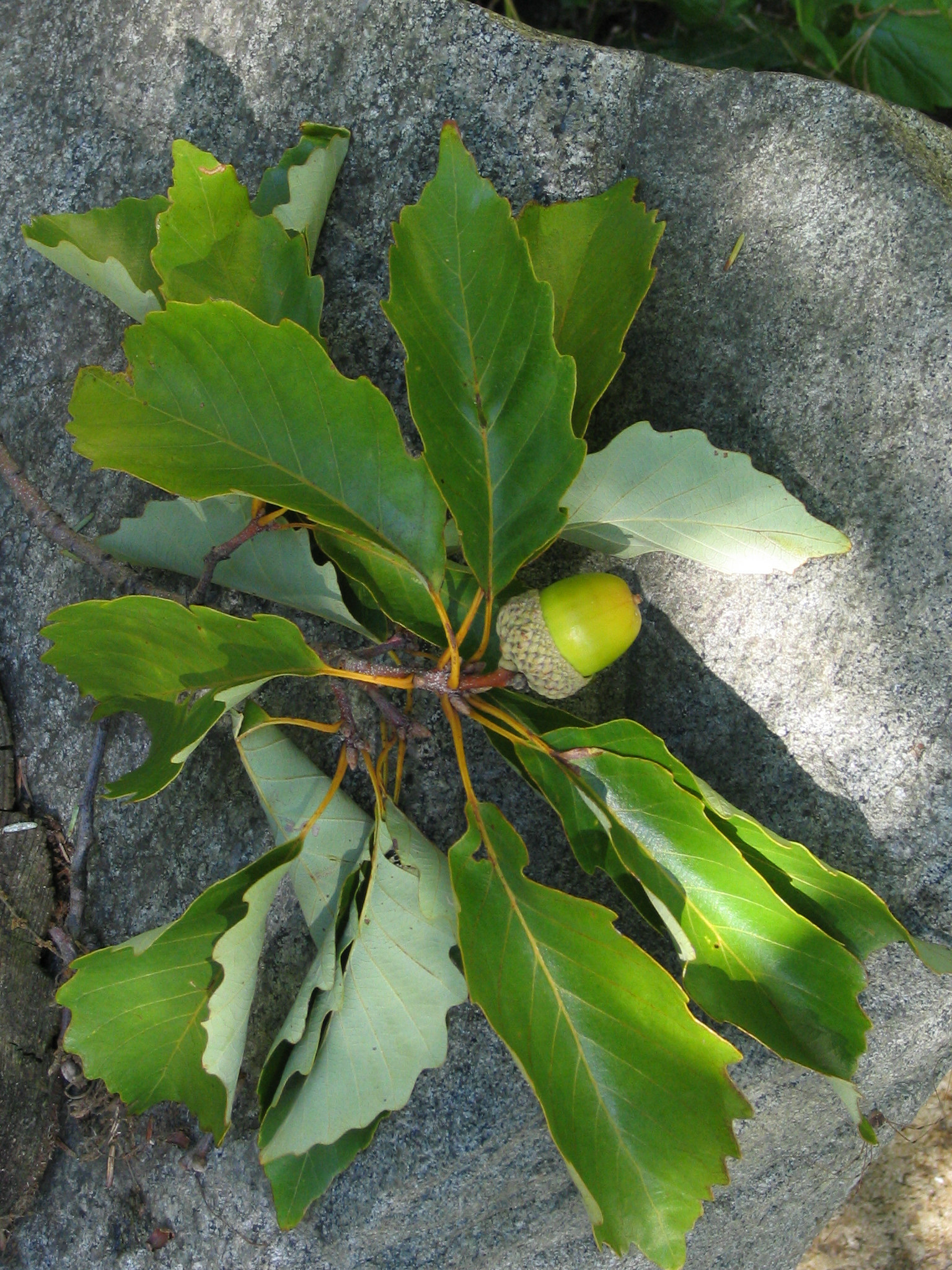- Chestnut oak
Taxobox
name = Chestnut Oak
status = LC

image_width = 240px
image_caption = Leaf cluster
regnum =Plant ae
divisio = Magnoliophyta
classis = Magnoliopsida
ordo =Fagales
familia =Fagaceae
genus = "Quercus"
sectio = "Quercus"
species = "Q. prinus"
binomial = "Quercus prinus L."The Chestnut oak ("Quercus prinus"; synonyms "Quercus montana Willd.","Quercus michauxii Nutt.") is a species of
oak in the white oak group, "Quercus" sect. "Quercus". It is native to the easternUnited States , where it is one of the most important ridgetop trees from southernMaine southwest to centralMississippi , with an outlying northwestern population in southernMichigan . It is also sometimes called "rock oak" because of montane and other rocky habitats. As a consequence of its dry habitat and ridgetop exposure, it is not usually a large tree, typically 18-22m (60-70 ft) tall; occasional specimens growing in better conditions can however become large, with trees up to 40-43 m (130-140 ft) tall known. They tend to have a similar spread of 18-22m (60-70 ft). A 10-year-old sapling will stand about 5 m (16 ft) tall. The trees are usually not the best timber trees because they are usually branched low and not very straight, but when they grow in better conditions, they are valuable fortimber . The timber is marketed as 'mixed white oak'.The Chestnut oak is readily identified by its massively-ridged dark gray-brown
bark , the thickest of any easternNorth America n oak. The leaves are 12-20 cm long and 6-10 cm broad, shallowly lobed with 10-15 rounded lobes on each margin; they are virtually identical to the leaves ofSwamp chestnut oak andChinkapin oak , but the trees can readily be distinguished by the bark, that of the Chinkapin oak being a light ash-gray and somewhat peeling like that of theWhite oak and that of Swamp chestnut oak being paler ash-gray and scaly. The chinkapin oak also has much smaller acorns than the chestnut oak. The Chestnut oak is easily distinguished from theSwamp white oak because that tree has whitened undersides on the leaves.Extensive confusion with the Swamp chestnut oak has occurred, and some botanists have considered them to be the same species in the past. The chief way to distinguish the two is by habitat; if it grows on a ridge, it is Chestnut oak, and if it grows in wet bottomlands, it is probably the more massive Swamp chestnut oak; however, this is not fully reliable.
The
acorn s are 1.5-3 cm long and 1-2 cm broad, among the largest of native American oaks, surpassed in size only by theBur oak and possibly Swamp chestnut oak, and are a valuable wildlife food.The Chestnut Oak is commonly known by the name "Quercus prinus", given by
Carolus Linnaeus , but the original specimen included a mixture of leaves from this and other species, and "Quercus prinus" is now considered by some a confused name to be rejected. The next-oldest name "Quercus montana", given by Willdenow, is the name recommended for the species by the Flora of North America. Currently however, the ITIS (Integrated Taxonomic Information System) still reports that "Q. prinus" is the accepted name.Description
* Bark: Dark, fissured into broad ridges, scaly. Branchlets stout, at first bronze green, later they become reddish brown, finally dark gray or brown. Heavily charged with tannic acid.
* Wood: Dark brown, sapwood lighter; heavy, hard, strong, tough, close-grained, durable in contact with the soil. Used for fencing, fuel, and railway ties. Sp. gr., 0.7499; weight of cu. ft., 46.73 lbs.
* Winter buds: Light chestnut brown, ovate, acute, one-fourth to one-half of an inch long.
* Leaves: Alternate, five to nine inches long, three to four and a half wide, obovate to oblong-lanceolate, wedge-shaped or rounded at base, coarsely crenately toothed, teeth rounded or acute, apex rounded or acute. They come out of the bud convolute, yellow green or bronze, shining above, very pubescent below. When full grown are thick, firm, dark yellow green, somewhat shining above, pale green and pubescent below; midribs stout, yellow, primary veins conspicuous. In autumn they turn a dull yellow soon changing to a yellow brown. Petioles stout or slender, short. Stipules linear to lanceolate, caducous.
* Flowers: May, when leaves are one-third grown. Staminate flowers are borne in hairy aments two to three inches long; calyx pale yellow, hairy, deeply seven to nine-lobed; stamens seven to nine; anthers bright yellow. Pistillate flowers on short spikes; peduncles green, stout, hairy; involucral scales hairy; stigmas short, bright red.
* Acorns: Annual, singly or in pairs; nut oval, rounded or acute at apex, bright chestnut brown, shining, one and a quarter to one and one-half inches in length; cup, cup-shaped or turbinate, usually inclosing one-half or one-third of the nut, thin, light brown and downy within, reddish brown and rought outside, tuberculate near the base. Scales small, much crowded toward the rim sometimes making a fringe. Kernel white, sweetish.cite book
last =Keeler
first =Harriet L.
title =Our Native Trees and How to Identify Them
publisher =Charles Scriber's Sons
date =1900
location =New York
pages =338-344 ]ee also
*
List of late spring flowers References
* [http://www.efloras.org/florataxon.aspx?flora_id=1&taxon_id=233501064 Flora of North America: "Quercus montana"] [http://www.efloras.org/object_page.aspx?object_id=6840&flora_id=1 Range
]
* [http://www.itis.gov/servlet/SingleRpt/SingleRpt?search_topic=TSN&search_value=19398 ITIS Taxonomic Report: "Quercus prinus L."]
* [http://www.itis.gov/servlet/SingleRpt/SingleRpt?search_topic=TSN&search_value=19379 ITIS Taxonomic Report: "Quercus montana" (synonum of Quercus prinus L.)]
* [http://plants.usda.gov/java/profile?symbol=QUPR2 USDA Plants Profile: "Quercus prinus L."]
Wikimedia Foundation. 2010.
